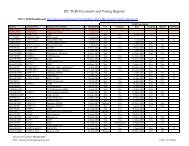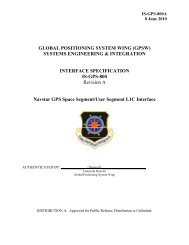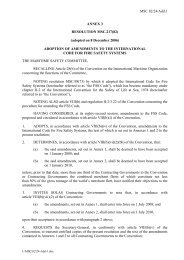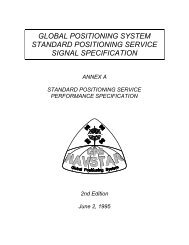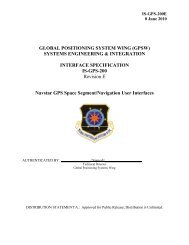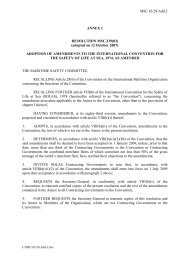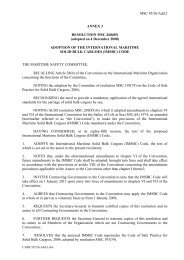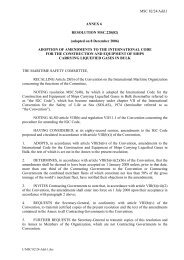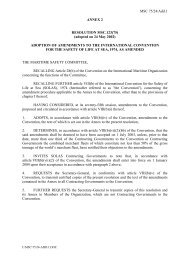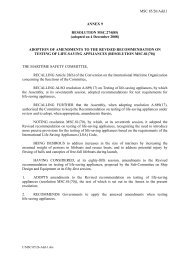The LORAN-C System - US Coast Guard Navigation Center
The LORAN-C System - US Coast Guard Navigation Center
The LORAN-C System - US Coast Guard Navigation Center
You also want an ePaper? Increase the reach of your titles
YUMPU automatically turns print PDFs into web optimized ePapers that Google loves.
Z = d am - d as(II-4)Z = ((Xa + 200) 2 + Y 2 a) .0.5 -((X a - 200) 2 + y 2 a) .0.5 (II-5)Figure II_3 shows how this distance difference function, Z, varies withthe location of the point A in the plane. (This figure is truncated atZ = -350 (point A 350 miles chosen to the master than to the secondary)and at Z = 350 (point A 350 miles closer to the secondary than to themaster).A more typical presentation of this difference function is to takeslices of this surface at various values for Z. <strong>The</strong>se slices (referredto as level curves, or constant differential distance contours) areshown in Figure II_4. Mathematically, these curves are hyperbolas.On a sphere (rather than the plane used in Figures II_3 and II_4) thesewould be spherical hyperbolas, while on the slightly nonspherical earththese would be spheroidal hyperbolas. (Readers accustomed to looking atrelatively large-scale loran overprinted nautical charts may besurprised at the curvature of the LOPs shown in Figure II_4. Over theshort distances covered by a large-scale charts the curvature of theloran LOPs is much less apparent.)<strong>The</strong> locus of points that have a constant difference in distance from amaster and secondary station describes a mathematical curve termed ahyperbola.To illustrate, suppose that point A were located at the point shown inFigure II_4, A = (271.9, 200). From equation (II_3), the distance frompoint A to the secondary would be approximately 212.5 nautical miles.And, from equation (II_2), the distance from point A to the masterwould be approximately 512.5 nautical miles. Point A, therefore, is 300miles closer to the X-ray secondary than to the master. Figure II_4also shows the locus of all such points 300 miles closer to thesecondary than to the master this contour is a hyperbola labeled withthe number 300. Thus, if we could determine that we were 300 milescloser to the secondary than to the master, we would be locatedsomewhere along this hyperbolic LOP (300).<strong>The</strong>se hyperbolic LOPs are all curved, with the exception of the LOPwhere the difference in distance is exactly zero. This is termed thecenterline of the system, and is a straight line (rather than a curve)that bisects the baseline. On the curved surface of the earth thecenterline is actually a great circle oriented at right angles to thebaseline. <strong>The</strong> baseline extension is also shown in Figure II_4.Equivalence Between Distance and Time<strong>The</strong> contours in Figure II_4 are labeled in terms of distance, but(assuming a constant speed of signal propagation) could equally well be




